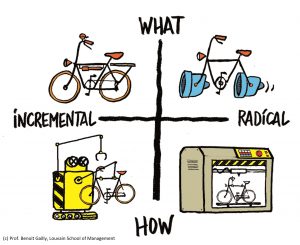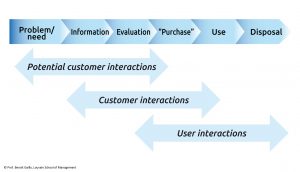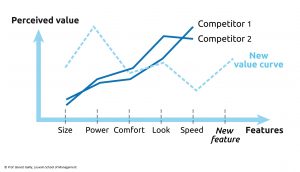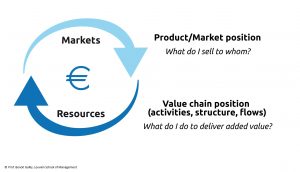NEW: Watch the executive summary
Innovation is about both making new things (“what”) and making similar things in new ways (“how”).
Innovation is about new value propositions, new ways to market to and interact with customers. This means much more than developing new products.
Innovation is also about finding new ways to differentiate, and new value curves that disrupt competitors but not customers.
Innovation is ultimately about designing new business models and combining new ways to deliver, share and capture value.
Bibliography
What is new: what vs. how
Keywords: administrative innovation, Industry 4.0, managerial innovation, organizational innovation, process innovation, product innovation
- (Book) Damanpour, F., & Aravind, D. (2006). ‘Product and process innovations: a review of organizational and envrionmental determinants’. In Hage J. and Meeus M., Innovation, Science, and Industrial Change: A Research Handbook,Oxford: Oxford University Press, 38-66.
- (Book) Mortensen, P. S., & Bloch, C. W. (2005) Oslo Manual-Guidelines for collecting and interpreting innovation data. Organization for Economic Cooperation and Development, OECD.
- (Video) IDEO shopping cart
- (Video) SE – Innovation by Fab Design (on Vimeo)
- (Video) The Zinnovants, “The different ways of innovating”
- (Article) Anzola-Román, P., Bayona-Sáez, C., & García-Marco, T. (2018). Organizational innovation, internal R&D and externally sourced innovation practices: Effects on technological innovation outcomes. Journal of Business Research, 91, 233-247.
- (Article) Ballot, G., Fakhfakh, F., Galia, F., & Salter, A. (2015). The fateful triangle: Complementarities in performance between product, process and organizational innovation in France and the UK. Research Policy, 44(1), 217-232.
- (Article) Brusoni, S., & Prencipe, A. (2006). Making design rules: A multidomain perspective. Organization Science, 17(2), 179-189.
- (Article) Camison, C., & Villar-Lopez, A. (2014). ‘Organizational innovation as an enabler of technological innovation capabilities and firm performance’. Journal of Business Research, 67, 2891-2902.
- (Article) Cooper, J. R. (1998). A multidimensional approach to the adoption of innovation. Management decision. 36(8), 493-502
- (Article) Damanpour, F. (1987). ‘The adoption of technological, administrative and ancillary innovations: impact of organizational factors’. Journal of Management, 13, 675-688.
- Article) Damanpour, F., & Gopalakrishnan, S. (2001). The dynamics of the adoption of product and process innovations in organizations. Journal of Management Studies, 38(1), 45-65.
- (Article) Damanpour, F., Walker, R. M., & Avellaneda, C. N. (2009). Combinative effects of innovation types and organizational performance: A longitudinal study of service organizations. Journal of Management Studies, 46(4), 650-675.
- (Article) Damanpour, F., & Aravind, D. (2011). ‘Managerial Innovation: Conceptions, Processes, and Antecedents’. Management and Organizational Review, 8, 423-454.
- (Article) Ettlie, J. E., & Reza, E. M. (1992). Organizational integration and process innovation. Academy of Management Journal, 35(4), 795-827.
- (Article) Fujimoto, T. (2014). The long tail of the auto industry life cycle. Journal of Product Innovation Management, 31(1), 8-16.
- (Article) Gault, F. (2018). Defining and measuring innovation in all sectors of the economy. Research Policy, 47(3), 617-622.
- (Article) Gopalakrishnan, S., Bierly, P., & Kessler, E. H. (1999). A reexamination of product and process innovations using a knowledge-based view. Journal of High Technology Management Research, 1(10), 147-166.
- (Article) Gopalakrishnan, S., & Damanpour, F. (1997). A review of innovation research in economics, sociology and technology management. Omega, 25(1), 15-28.
- (Article) Hobday, M. (1998). Product complexity, innovation and industrial organisation. Research Policy, 26(6), 689-710.
- (Article) Hullova, D., Simms, C. D., Trott, P., & Laczko, P. (2019). Critical capabilities for effective management of complementarity between product and process innovation: Cases from the food and drink industry. Research Policy, 48(1), 339-354.
- (Article) Kariv, D., Krueger, N., Kashy, G., & Cisneros, L. (2024). Process innovation is technology transfer too! How entrepreneurial businesses manage product and process innovation. The Journal of Technology Transfer, 1-25.
- (Article) Khosravi, P., Newton, C., & Rezvani, A. (2019). Management innovation: A systematic review and meta-analysis of past decades of research. European Management Journal, 37(6), 694-707.
- (Article) Mann, D. L. (2003). Better technology forecasting using systematic innovation methods. Technological Forecasting and Social Change, 70(8), 779-795.
- (Article) Mol, M. J., & Birkinshaw, J. (2009). The sources of management innovation: When firms introduce new management practices. Journal of Business Research, 62(12), 1269-1280.
- (Article) Mothe, C., & Nguyen-Thi, T. U. (2013). Sources of information for organisational innovation: a sector comparative approach. International Journal of Technology Management, 63(1-2), 125-144.
- (Article) Pérez, J. A. H., Geldes, C., Kunc, M. H., & Flores, A. (2019). New approach to the innovation process in emerging economies: The manufacturing sector case in Chile and Peru. Technovation, 79, 35-55.
- (Article) Rowley, J., Baregheh, A., & Sambrook, S. (2011). Towards an innovation-type mapping tool. Management Decision, 49(1), 73-86.
- (Article) Sapprasert, K., & Clausen, T. H. (2012). Organizational innovation and its effects. Industrial and Corporate Change, 21(5), 1283-1305.
- (Article) Tavassoli, S., & Karlsson, C. (2015). Persistence of various types of innovation analyzed and explained. Research Policy, 44(10), 1887-1901.
- (Article) Vargo, S.L. and Robert F. Lusch (2004) The Four Service Marketing Myths: Remnants of a Goods-Based, Manufacturing Model, Journal of Service Research, May 2004 6: 324-335
New value propositions and new interactions
Keywords: customer interaction, differentiation, new value proposition, product-as-a-service, service innovation, servitization
- (Book) Baines, T., & Lightfoot, H. (2013) Made to Serve: How manufacturers can compete through servitization and product service systems. John Wiley & Sons.
- (Book) Hull, F. and Tidd, J. (2003) Service Innovation: Organizational Responses to Technological Opportunities and Market Imperatives. Imperial College Press, London.
- (Book) Johnson, S. P., Menor, L. J., Roth, A. V., & Chase, R. B. (2000). A critical evaluation of the new service development process. New service development: Creating memorable experiences, SAGE Publications, Inc
- (Book) Sundbo, J., & Gallouj, F. (2000). Innovation as a loosely coupled system in services. In Innovation systems in the service economy (pp. 43-68). Springer, Boston, MA.
- (Video) Product as a service – Red Hat
- (Video) What is Servitization? (The Advanced Services Group)
- (Article) Aarikka-Stenroos, L., & Jaakkola, E. (2012). Value co-creation in knowledge intensive business services: A dyadic perspective on the joint problem solving process. Industrial Marketing Management, 41(1), 15-26.
- (Article) Aas, T. H., Breunig, K. J., Hydle, K. M., & Pedersen, P. E. (2015). Innovation management practices in production-intensive service firms. International Journal of Innovation Management, 19(05), 1550055.
- (Article) Baines, T. S., Lightfoot, H. W., Benedettini, O., & Kay, J. M. (2009). The servitization of manufacturing: A review of literature and reflection on future challenges. Journal of Manufacturing Technology Management, 20(5), 547-567.
- (Article) Barras, R. (1986). Towards a theory of innovation in services. Research Policy, 15(4), 161-173.
- (Article) Benedettini, O., Neely, A., & Swink, M. (2015). Why do servitized firms fail? A risk-based explanation. International Journal of Operations & Production Management. 35(6)
- (Article) Beuren, F. H., Ferreira, M. G. G., & Miguel, P. A. C. (2013). Product-service systems: a literature review on integrated products and services. Journal of Cleaner Production, 47, 222-231.
- (Article) Bitner, Mary Jo, Amy L. Ostrom, and Felicia N. Morgan. “Service blueprinting: a practical technique for service innovation.” California Management Review 50.3 (2008): 66-94.
- (Article) Cohen, M. A., Agrawal, N., & Agrawal, V. (2006). Winning in the aftermarket. Harvard Business Review, 84(5), 129.
- (Article) Chesbrough, H. W. (2011). Bringing open innovation to services. MIT Sloan Management Review, 52(2), 85.
- (Article) Davies, A., Brady, T., & Hobday, M. (2006). Charting a path toward integrated solutions. MIT Sloan Management Review, 47(3), 39.
- (Article) De Jong, J. P., & Vermeulen, P. A. (2003). Organizing successful new service development: a literature review. Management Decision, 41(9), 844-858.
- (Article) Droege, H., Hildebrand, D., Forcada, H., & Miguel, A. (2009). ‘Innovation in services: present findings, and future pathways’. Journal of Service Management, 20, 131-155.
- (Article) Gallouj, F. & Weinstein, O. (1997). “Innovation in services”, Research Policy, 26, 537-556.
- (Article) Gebauer, H., Fleisch, E., & Friedli, T. (2005). Overcoming the service paradox in manufacturing companies. European Management Journal, 23(1), 14-26.
- (Article) Gebauer, H., Gustafsson, A., & Witell, L. (2011). Competitive advantage through service differentiation by manufacturing companies. Journal of Business Research, 64(12), 1270-1280.
- (Article) Johne, A., & Storey, C. (1998). New service development: a review of the literature and annotated bibliography. European Journal of Marketing, 32(3/4), 184-251.
- (Article) Kahn, K. B. (2018). Understanding innovation. Business Horizons, 61(3), 453-460.
- (Article) Kindström, D. (2010). Towards a service-based business model–Key aspects for future competitive advantage. European Management Journal, 28(6), 479-490.
- (Article) Kindström, D., Kowalkowski, C., & Sandberg, E. (2013). Enabling service innovation: A dynamic capabilities approach. Journal of Business Research, 66(8), 1063-1073.
- (Article) Kowalkowski, C., Gebauer, H., Kamp, B., & Parry, G. (2017). Servitization and deservitization: Overview, concepts, and definitions. Industrial Marketing Management, 60, 4-10
- (Article) Lusch, R. F., & Nambisan, S. (2015). Service innovation: A service-dominant logic perspective. MIS Quarterly, 39(1).
- (Article) Mathieu, V. (2001). Product services: from a service supporting the product to a service supporting the client. Journal of Business & Industrial Marketing.
- (Article) Miles, I. (2000). Services innovation: coming of age in the knowledge-based economy. International Journal of Innovation Management, 4(04), 371-389.
- (Article) Mont, O. K. (2002). Clarifying the concept of product–service system. Journal of Cleaner Production, 10(3), 237-245.
- (Article) Mothe, C., & Thi, T. U. N. (2010). The link between non‐technological innovations and technological innovation. European Journal of Innovation Management , 13(3), 313-332
- (Article) Ordanini, A., Parasuraman, A., & Rubera, G. (2014). When the recipe is more important than the ingredients: A qualitative comparative analysis (QCA) of service innovation configurations. Journal of Service Research, 17(2), 134-149.
- (Article) Russo-Spena, T., & Mele, C. (2012). “Five Co-s” in innovating: a practice-based view. Journal of Service Management, 23(4), 527-553.
- (Article) Skålén, P., Gummerus, J., von Koskull, C., & Magnusson, P. R. (2015). Exploring value propositions and service innovation: a service-dominant logic study. Journal of the Academy of Marketing Science, 43(2), 137-158.
- (Article) Stauss, B., den Hertog, P., van der Aa, W., & de Jong, M. W. (2010). Capabilities for managing service innovation: towards a conceptual framework. Journal of Service Management. 21(4), 490-514
- (Article) Storey, C., & Easingwood, C. J. (1998). The augmented service offering: a conceptualization and study of its impact on new service success. Journal of Product Innovation Management, 15(4), 335-351.
- (Article) Tukker, A., & Tischner, U. (2006). Product-services as a research field: past, present and future. Reflections from a decade of research. Journal of Cleaner Production, 14(17), 1552-1556
- (Article) Vandermerwe, S., & Rada, J. (1988). Servitization of business: adding value by adding services. European Management Journal, 6(4), 314-324.
- (Article) Vargo, S.L. and Robert F. Lusch (2004) Evolving to a New Dominant Logic for Marketing Journal of Marketing Vol. 68, No. 1 (Jan., 2004) , pp. 1-17
- (Article) Visnjic, I., Ringov, D., & Arts, S. (2019). Which Service? How Industry Conditions Shape Firms’ Service‐Type Choices. Journal of Product Innovation Management.
- (Article) Witell, L., & Löfgren, M. (2013). From service for free to service for fee: business model innovation in manufacturing firms. Journal of Service Management, 24(5), 520-533.
- (Article) Witell, L., Snyder, H., Gustafsson, A., Fombelle, P., & Kristensson, P. (2016). Defining service innovation: A review and synthesis. Journal of Business Research, 69(8), 2863-2872.
- (Article) Zhang, M., Zhao, X., Voss, C., & Zhu, G. (2016). Innovating through services, co-creation and supplier integration: Cases from China. International Journal of Production Economics, 171, 289-300.
New and disruptive value curves
Keywords: disruptive innovation, frugal innovation, quality, social innovation, value curve, value innovation
- (Book) Christensen, C. (1997) The Innovator’s Dilemma. When new technologies cause great firms to fail, Harvard Business School
- (Book) Christensen, C.M. and Raynor, M.E. (2003) The Innovator’s solution, Harvard Business School Press
- (Book) Michelini, L. (2012). Social innovation and new business models: creating shared value in low-income markets. Springer Science & Business Media.
- (Book) Radjou, N., Prabhu, J., & Ahuja, S. (2012). Jugaad innovation: Think frugal, be flexible, generate breakthrough growth. John Wiley & Sons.
- (Video) Blue Ocean Strategy
- (Video) Value Matters: Innovation Has Direction (dMASS)
- (Video) The Explainer: Disruptive Innovation (Harvard Business Review)
- (Video) Clayton M. Christensen on Disruptive Innovation (Published on 1 Jul 2012)
- (Video) Navi Radjou (2014), Creative problem-solving in the face of extreme limits
- (Article) Adner, R. (2002). When are technologies disruptive? A demand‐based view of the emergence of competition. Strategic Management Journal, 23(8), 667-688.
- (Article) Adner, R., & Zemsky, P. (2005). Disruptive technologies and the emergence of competition. RAND Journal of Economics, 229-254.
- (Article) Altmann, P., & Engberg, R. (2016). Frugal Innovation and Knowledge Transferability. Research-Technology Management, 59(1), 48-55.
- (Article) Ansari, S.S., Garud, R., & Kumaraswamy, A. (2016). The disruptor’s dilemma: TiVo and the US television ecosystem. Strategic Management Journal, 37(9), 1829-1853.
- (Article) Bower, J. L., & Christensen, C. M. (1995). Disruptive technologies: catching the wave. Harvard Business Review, 13(1), 43-53.
- (Article) Cajaiba-Santana, G. (2014). Social innovation: Moving the field forward. A conceptual framework. Technological Forecasting and Social Change, 82, 42-51.
- (Article) Charitou, C. D., & Markides, C. C. (2002). Responses to disruptive strategic innovation. MIT Sloan Management Review, 44(2), 55-64.
- (Article) Christensen, C.M., & Bower, J.L. (1996). Customer power, strategic investment, and the failure of leading firms. Strategic Management Journal, 197-218.
- (Article) Christensen, C. M., Johnson, M. W., & Rigby, D. K. (2002). Foundations for growth: How to identify and build disruptive new businesses. MIT Sloan Management Review, 43(3), 22.
- (Article) Christensen, C., & Euchner, J. (2011). Managing disruption: an interview with Clayton Christensen. Research-Technology Management, 54(1), 11-17.
- (Article) Christensen, C. M., Raynor, M. E., & McDonald, R. (2015). What is disruptive innovation. Harvard Business Review, 93(12), 44-53.
- (Article) Christensen, C. M., McDonald, R. , Altman, E. J. and Palmer, J. E. (2018), Disruptive Innovation: An Intellectual History and Directions for Future Research. Journal of Management Studies, Accepted Author Manuscript.
- (Article) Dabić, M., Obradović, T., Vlačić, B., Sahasranamam, S., & Paul, J. (2022). Frugal innovations: A multidisciplinary review & agenda for future research. Journal of Business Research, 142, 914-929.
- (Article) Dahan, N. M., Doh, J. P., Oetzel, J., & Yaziji, M. (2010). Corporate-NGO collaboration: Co-creating new business models for developing markets. Long Range Planning, 43(2-3), 326-342.
- (Article) Danneels, E. (2004). Disruptive technology reconsidered: A critique and research agenda. Journal of Product Innovation Management, 21(4), 246-258.
- (Article) Denning, S. (2005). Why the best and brightest approaches don’t solve the innovation dilemma. Strategy & Leadership, 33(1), 4-11.
- (Article) Dillon, T. A., Lee, R. K., & Matheson, D. (2005). Value innovation: Passport to wealth creation. Research-Technology Management, 48(2), 22-36.
- (Article) Ernst, H., Kahle, H. N., Dubiel, A., Prabhu, J., & Subramaniam, M. (2015). The antecedents and consequences of affordable value innovations for emerging markets. Journal of Product Innovation Management, 32(1), 65-79.
- (Article) Govindarajan, V., & Kopalle, P. K. (2006). The usefulness of measuring disruptiveness of innovations ex post in making ex ante predictions. Journal of Product Innovation Management, 23(1), 12-18.
- (Article) Hang, C. C., Chen, J., & Subramian, A. M. (2010). Developing disruptive products for emerging economies: Lessons from Asian cases. Research-Technology Management, 53(4), 21-26
- (Article) Hossain, M. (2018). Frugal innovation: A review and research agenda. Journal of Cleaner Production, 182, 926-936.
- (Article) Keupp, M., Palmiè, M., & Gassmann, O. (2012). ‘A reflective review of disruptive innovation theory’. International Journal of Management Review, 14, 367-390.
- (Article) King, Andrew A., and Baljir Baatartogtokh. “How useful is the theory of disruptive innovation?.” MIT Sloan Management Review, 57.1 (2015): 77.
- (Article) Lim, C., & Fujimoto, T. (2019). Frugal innovation and design changes expanding the cost-performance frontier: A Schumpeterian approach. Research Policy, 48(4), 1016-1029.
- (Article) Markides, C. (2006). Disruptive innovation: In need of better theory. Journal of Product Innovation Management, 23(1), 19-25.
- (Article) Markides, C., & Oyon, D. (2010). What to do against disruptive business models (when and how to play two games at once). MIT Sloan Management Review, 51(4), 25.
- (Article) Mumford, M. D. (2002). Social innovation: ten cases from Benjamin Franklin. Creativity Research Journal, 14(2), 253-266.
- (Article) Pisoni, A., Michelini, L., & Martignoni, G. (2018). Frugal approach to innovation: State of the art and future perspectives. Journal of Cleaner Production, 171, 107-126
- (Article) Pol, E., & Ville, S. (2009). Social innovation: Buzz word or enduring term?. The Journal of Socio-economics, 38(6), 878-885.
- (Article) Prahalad, C. K., & Mashelkar, R. A. (2010). Innovation’s holy grail. Harvard Business Review, 88(7/8), 132-141.
- (Article) Sanchez, P., & Ricart, J. E. (2010). Business model innovation and sources of value creation in low‐income markets. European Management Review, 7(3), 138-154.
- (Article) Schmidt, Glen M., and Cheryl T. Druehl.(2008) “When is a disruptive innovation disruptive?.” Journal of Product Innovation Management, 25(4), 347-369.
- (Article) Van der Have, R. P., & Rubalcaba, L. (2016). Social innovation research: An emerging area of innovation studies?. Research Policy, 45(9), 1923-1935.
- (Article) Van Orden, J., van der Rhee, B., & Schmidt, G. M. (2011). Encroachment patterns of the “best products” from the last decade. Journal of Product Innovation Management, 28(5), 726-743.
- (Article) Williamson, P. J. (2010). Cost innovation: preparing for a ‘value-for-money’revolution. Long Range Planning, 43(2-3), 343-353.
- (Article) Winterhalter, S., Zeschky, M. B., Neumann, L., & Gassmann, O. (2017). Business models for frugal innovation in emerging markets: the case of the medical device and laboratory equipment industry. Technovation, 66, 3-13.
- (Article) Yu, D., & Hang, C. C. (2010). A reflective review of disruptive innovation theory. International Journal of Management Reviews, 12(4), 435-452.
- (Article) Zeschky, M., Widenmayer, B., & Gassmann, O. (2011). Frugal innovation in emerging markets. Research-Technology Management, 54(4), 38-45.
- (Article) Zeschky, M. B., Winterhalter, S., & Gassmann, O. (2014). From cost to frugal and reverse innovation: Mapping the field and implications for global competitiveness. Research-Technology Management, 57(4), 20-27.
- (Article) Zietsma, C., Ruebottom, T., & Slade Shantz, A. (2018). Unobtrusive maintenance: temporal complexity, latent category control and the stalled emergence of the cleantech sector. Journal of Management Studies, 55(7), 1242-1277.
New business models
Keywords: business model innovation, Innovation Readiness Level, platforms
- (Book) Gassmann, O., Frankenberger, K., & Csik, M. (2014) The business model navigator: 55 models that will revolutionize your business. London: Pearson UK.
- (Book) Keeley, L., Walters, H., Pikkel, R., & Quinn, B. (2013). Ten types of innovation: The discipline of building breakthroughs. John Wiley & Sons.
- (Video) CucinaBarilla
- (Video) Hadyn Parry:Re-engineering mosquitos to fight disease (TED talk)
- (Video) What is Innovation Management by Dr Julian Birkinshaw
- (Video) Business Model Innovation – The secret behind Amazon, Spotify and Tinder success (2017).
- (Article) Clauss, T. (2017). Measuring business model innovation: conceptualization, scale development, and proof of performance. R&D Management, 47(3), 385-403.
- (Article) Desyllas, P., & Sako, M. (2013). Profiting from business model innovation: Evidence from Pay-As-You-Drive auto insurance. Research Policy, 42(1), 101-116.
- (Article) Evans, D. S., & Schmalensee, R. (2005). The industrial organization of markets with two-sided platforms (No. w11603). National Bureau of Economic Research.
- (Article) Fehrer, J. A., Woratschek, H., & Brodie, R. J. (2018). A systemic logic for platform business models. Journal of Service Management, 29(4), 546-568.
- (Article) Foss, N. J., & Saebi, T. (2017). Fifteen years of research on business model innovation: How far have we come, and where should we go?. Journal of Management, 43(1), 200-227.
- (Article) George, G. & Bock, A. (2011). “The business model in practice and its implication for entrepreneurship research”; Entrepreneurship Theory and Practice, 35(1), 83-111.
- (Article) Henry, M., Bauwens, T., Hekkert, M., & Kirchherr, J. (2019). A typology of circular start-ups: Analysis of 128 circular business models. Journal of Cleaner Production, 118528.
- (Article) Markides, C. (1997). Strategic Innovation. Sloan Management Review, Spring, 9-23.
- (Article) Matzler, K., Bailom, F., Friedrich von den Eichen, S., & Kohler, T. (2013). Business model innovation: coffee triumphs for Nespresso. Journal of Business Strategy, 34(2), 30-37.
- (Article) McDonald, R. E., Masselli, J. J., & Chanda, B. (2019). Nonprofit business model innovation as a response to existential environmental threats: Performing arts in the United States. Journal of Business Research.
- (Article) Menter, M., Göcke, L., & Zeeb, C. (2023) The organizational impact of business model innovation: assessing the person‐organization fit. Journal of Management Studies. https://doi.org/10.1111/joms.12902
- (Article) Osterwalder, A., Pigneur, Y., & Tucci, C. L. (2005). Clarifying business models: Origins, present, and future of the concept. Communications of the association for Information Systems, 16(1), 1.
- (Article) Remane, G., Hanelt, A., Tesch, J. F., & Kolbe, L. M. (2017). The business model pattern database – A tool for systematic business model innovation. International Journal of Innovation Management, 21(1)
- (Article) Rietveld, J., Schilling, M. A., & Bellavitis, C. (2019). Platform strategy: Managing ecosystem value through selective promotion of complements. Organization Science.
- (Article) Schneider, S., & Spieth, P. (2013). Business model innovation: Towards an integrated future research agenda. International Journal of Innovation Management, 17, 134-156.
- (Article) Sorescu, A., Frambach, R. T., Singh, J., Rangaswamy, A., & Bridges, C. (2011). Innovations in retail business models. Journal of Retailing, 87, S3-S16.
- (Article) Spieth, P., Schneckenberg, D., & Ricart, J. E. (2014). Business model innovation–state of the art and future challenges for the field. R&D Management, 44(3), 237-247.
- (Article) Taran, Y., Boer, H., & Lindgren, P. (2015). A business model innovation typology. Decision Sciences, 46(2), 301-331.
- (Article) Teece (2010) “Business models, business strategy and innovation.”, Long Range Planning, 43(2), 172-194.
- (Article) Teece, D. J. (2018). Business models and dynamic capabilities. Long Range Planning, 51(1), 40-49.
(c) Prof. Benoit Gailly, Louvain School of Management


